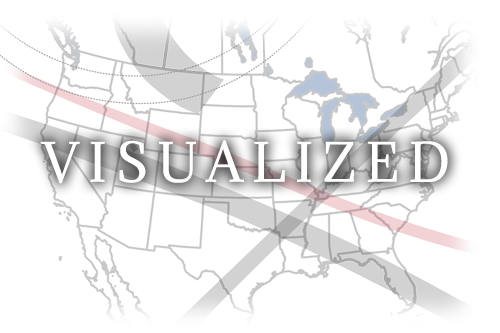IntroSlide
The day the sky
goes dark
August 21, 2017 | Total Solar Eclipse
Visualizing the eclipse

A total eclipse of the heartland
The moon will pass between the sun and Earth on Aug. 21 casting a shadow that will travel across the country from coast to coast. It will be the first total eclipse over the contiguous United States in 38 years.
The eclipse path
How to view eclipse
To view the partially eclipsed sun, eye protection is required.
The solar eclipse will cut a swath across the U.S., and a narrow segment from Oregon to South Carolina will experience more than two minutes when the sun is blocked totally by the moon.
“Eclipse glasses” or hand-held viewers should meet the ISO 12312-2
international standard.
A No. 14 arc welder’s glass can be used safely to view the eclipse directly.
10:15 a.m.
(PDT)
10:30 a.m.
(PDT)
11:45 a.m.
(MDT)
1 p.m.
(CDT)
1:15 p.m.
(CDT)
2:30 p.m.
(EDT)
2:45 p.m.
(EDT)
Sun
obscured
60%
Duration of totality
(minutes:seconds)
70%
total
eclIPSe
80%
90%
Simple projector
Poke a small hole in an index card with a pencil tip. Hold another card 3 to 4 feet behind in its shadow. All eclipse phases can be safely viewed on the face of the card.
100%
90%
40%
50%
60%
70%
80%
Celestial alignment
As the moon orbits the Earth — traveling in tandem around the sun — it occasionally passes between the earth and the sun. Within the shadow cast on the earth, the moon is seen to block out — or eclipse —the disk of the sun, either totally or partially.
Index
card
Pinhole
Index
card
3 to 4 feet
It takes light from the sun
eight minutes, 20 seconds to travel the 92.9 million miles to Earth.
Eclipse
projection
Earth
Moon
Total eclipses over U.S., through 2050
A total eclipse of the sun will happen over the contiguous 48 states only four times between now and 2050. The 2017 total eclipse is the first to touch the U.S. mainland since Feb. 26, 1979.
(Not to scale)
Path of eclipse
Penumbra (partial eclipse)
Umbra
(total eclipse)
Sun
Aug. 23, 2044
AUG. 21
Sources: NASA;
greatamericaneclipse.com;
American Astronomical Society;
Photo: Kate Russo; maps4news.com/©HERE
Aug. 12, 2045
April 8, 2024
Graphic by Justin gilbert/GATEHOUSE MEDIA

A total eclipse
of the heartland
The moon will pass between the sun and Earth on Aug. 21 casting a shadow that will travel across the country from coast to coast. It will be the first total eclipse over the contiguous United States in 38 years.
The eclipse path
The solar eclipse will cut a swath across the U.S., and a narrow segment from Oregon to South Carolina will experience more than two minutes when the sun is blocked totally by the moon.
10:15 a.m.
(PDT)
10:30 a.m.
(PDT)
11:45 a.m.
(MDT)
1 p.m.
(CDT)
1:15 p.m.
(CDT)
2:30 p.m.
(EDT)
2:45 p.m.
(EDT)
Sun
obscured
60%
Duration of totality
(minutes:seconds)
70%
total
eclIPSe
80%
90%
100%
90%
40%
50%
60%
70%
80%
How to view eclipse
To view the partially eclipsed sun, eye protection is required.
“Eclipse glasses” or hand-held viewers should meet the ISO 12312-2
international standard.
A No. 14 arc welder’s glass can be used safely to view the eclipse directly.
Simple projector
Poke a small hole in an index card with a pencil tip. Hold another card 3 to 4 feet behind in its shadow. All eclipse phases can be safely viewed on the face of the card.
Pinhole
Index
card
Index
card
3 to 4 feet
Eclipse
projection
Celestial alignment
As the moon orbits the Earth — traveling in tandem around the sun — it occasionally passes between the earth and the sun. Within the shadow cast on the earth, the moon is seen to block out — or eclipse —the disk of the sun, either totally or partially.
Path of eclipse
It takes light from the sun
eight minutes, 20 seconds to travel the 92.9 million miles to Earth.
Earth
Moon
(Not to scale)
Penumbra (partial eclipse)
Umbra
(total eclipse)
Sun
Total eclipses over U.S.,
through 2050
A total eclipse of the sun will happen over the contiguous 48 states only four times between now and 2050. The 2017 total eclipse is the first to touch the U.S. mainland since Feb. 26, 1979.
Aug. 23, 2044
AUG. 21
Aug. 12, 2045
April 8, 2024
Sources: NASA;
greatamericaneclipse.com;
American Astronomical Society;
Photo: Kate Russo; maps4news.com/©HERE
Graphic by Justin gilbert/GATEHOUSE MEDIA



